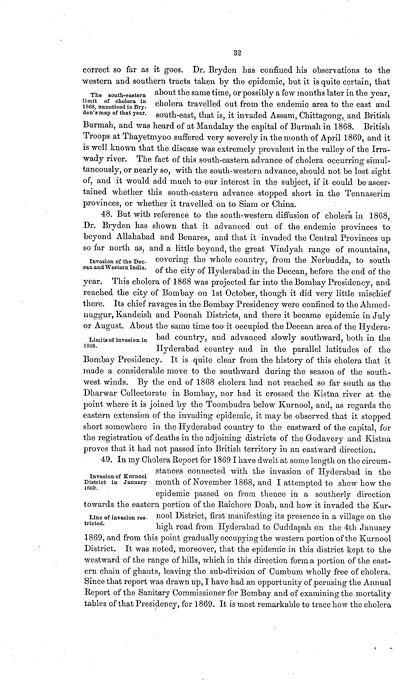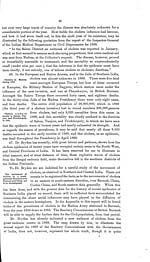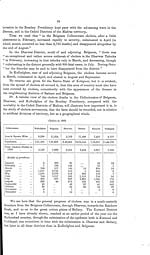Medicine - Disease > Cholera in southern India
(55) Page 32
Download files
Individual page:
Thumbnail gallery: Grid view | List view

32
The south-eastern
limit of cholera in
1868, unnoticed in Bry-
den's map of that year.
correct so far as it goes. Dr. Bryden has confined his observations to the
western and southern tracts taken by the epidemic, but it is quite certain, that
about the same time, or possibly a few months later in the year,
cholera travelled out from the endemic area to the east and
south-east, that is, it invaded Assam, Chittagong, and British
Burmah, and was heard of at Mandalay the capital of Burmah in 1868. British
Troops at Thayetmyoo suffered very severely in the month of April 1869, and it
is well known that the disease was extremely prevalent in the valley of the Irra-
wady river. The fact of this south-eastern advance of cholera occurring simul-
taneously, or nearly so, with the south-western advance, should not be lost sight
of, and it would add much to our interest in the subject, if it could be ascer-
tained whether this south-eastern advance stopped short in the Tennaserim.
provinces, or whether it travelled on to Siam or China.
Invasion of the Dec-
can and Western India.
Limits of invasion in
1868.
48. But with reference to the south-western diffusion of cholera in 1868,
Dr. Bryden has shown that it advanced out of the endemic provinces to
beyond Allahabad and Benares, and that it invaded the Central Provinces up
so far north as, and a little beyond, the great Vindyah range of mountains,
covering the whole country, from the Nerbudda, to south
of the city of Hyderabad in the Deccan, before the end of the
year. This cholera of 1868 was projected far into the Bombay Presidency, and
reached the city of Bombay on 1st October, though it did very little mischief
there. Its chief ravages in the Bombay Presidency were confined to the Ahmed-
nuggur, Kandeish and Poonah Districts, and there it became epidemic in July
or August. About the same time too it occupied the Deccan area of the Hydera-
bad country, and advanced slowly southward, both in the
Hyderabad country and in the parallel latitudes of the
Bombay Presidency. It is quite clear from the history of this cholera that it
made a considerable move to the southward during the season of the south-
west winds. By the end of 1868 cholera had not reached so far south as the
Dharwar Collectorate in Bombay, nor had it crossed the Kistna river at the
point where it is joined by the Toombudra below Kurnool, and, as regards the
eastern extension of the invading epidemic, it may be observed that it stopped
short somewhere in the Hyderabad country to the eastward of the capital, for
the registration of deaths in the adjoining districts of the Godavery and Kistna
proves that it had not passed into British territory in an eastward direction.
Invasion of Kurnool
District in January
1869.
Line of invasion res-
tricted.
49. In my Cholera Report for 1869 I have dwelt at some length on the circum-
stances connected with the invasion of Hyderabad in the
month of November 1868, and I attempted to show how the
epidemic passed on from thence in a southerly direction
towards the eastern portion of the Raichore Doab, and how it invaded the Kur-
nool District, first manifesting its presence in a village on the
high road from Hyderabad to Cuddapah on the 4th January
1869, and from this point gradually occupying the western portion of the Kurnool
District. It was noted, moreover, that the epidemic in this district kept to the
westward of the range of hills, which in this direction form a portion of the east-
ern chain of ghauts, leaving the sub-division of Cumbum wholly free of cholera.
Since that report was drawn up, I have had an opportunity of perusing the Annual
Report of the Sanitary Commissioner for Bombay and of examining the mortality
tables of that Presidency, for 1869. It is most remarkable to trace how the cholera
The south-eastern
limit of cholera in
1868, unnoticed in Bry-
den's map of that year.
correct so far as it goes. Dr. Bryden has confined his observations to the
western and southern tracts taken by the epidemic, but it is quite certain, that
about the same time, or possibly a few months later in the year,
cholera travelled out from the endemic area to the east and
south-east, that is, it invaded Assam, Chittagong, and British
Burmah, and was heard of at Mandalay the capital of Burmah in 1868. British
Troops at Thayetmyoo suffered very severely in the month of April 1869, and it
is well known that the disease was extremely prevalent in the valley of the Irra-
wady river. The fact of this south-eastern advance of cholera occurring simul-
taneously, or nearly so, with the south-western advance, should not be lost sight
of, and it would add much to our interest in the subject, if it could be ascer-
tained whether this south-eastern advance stopped short in the Tennaserim.
provinces, or whether it travelled on to Siam or China.
Invasion of the Dec-
can and Western India.
Limits of invasion in
1868.
48. But with reference to the south-western diffusion of cholera in 1868,
Dr. Bryden has shown that it advanced out of the endemic provinces to
beyond Allahabad and Benares, and that it invaded the Central Provinces up
so far north as, and a little beyond, the great Vindyah range of mountains,
covering the whole country, from the Nerbudda, to south
of the city of Hyderabad in the Deccan, before the end of the
year. This cholera of 1868 was projected far into the Bombay Presidency, and
reached the city of Bombay on 1st October, though it did very little mischief
there. Its chief ravages in the Bombay Presidency were confined to the Ahmed-
nuggur, Kandeish and Poonah Districts, and there it became epidemic in July
or August. About the same time too it occupied the Deccan area of the Hydera-
bad country, and advanced slowly southward, both in the
Hyderabad country and in the parallel latitudes of the
Bombay Presidency. It is quite clear from the history of this cholera that it
made a considerable move to the southward during the season of the south-
west winds. By the end of 1868 cholera had not reached so far south as the
Dharwar Collectorate in Bombay, nor had it crossed the Kistna river at the
point where it is joined by the Toombudra below Kurnool, and, as regards the
eastern extension of the invading epidemic, it may be observed that it stopped
short somewhere in the Hyderabad country to the eastward of the capital, for
the registration of deaths in the adjoining districts of the Godavery and Kistna
proves that it had not passed into British territory in an eastward direction.
Invasion of Kurnool
District in January
1869.
Line of invasion res-
tricted.
49. In my Cholera Report for 1869 I have dwelt at some length on the circum-
stances connected with the invasion of Hyderabad in the
month of November 1868, and I attempted to show how the
epidemic passed on from thence in a southerly direction
towards the eastern portion of the Raichore Doab, and how it invaded the Kur-
nool District, first manifesting its presence in a village on the
high road from Hyderabad to Cuddapah on the 4th January
1869, and from this point gradually occupying the western portion of the Kurnool
District. It was noted, moreover, that the epidemic in this district kept to the
westward of the range of hills, which in this direction form a portion of the east-
ern chain of ghauts, leaving the sub-division of Cumbum wholly free of cholera.
Since that report was drawn up, I have had an opportunity of perusing the Annual
Report of the Sanitary Commissioner for Bombay and of examining the mortality
tables of that Presidency, for 1869. It is most remarkable to trace how the cholera
Set display mode to: Large image | Zoom image | Transcription
Images and transcriptions on this page, including medium image downloads, may be used under the Creative Commons Attribution 4.0 International Licence unless otherwise stated. ![]()
| India Papers > Medicine - Disease > Cholera in southern India > (55) Page 32 |
|---|
| Permanent URL | https://digital.nls.uk/74534270 |
|---|




